Signs of life: from lambs to lilies, Catholics decorate their churches and homes with symbols of Easter
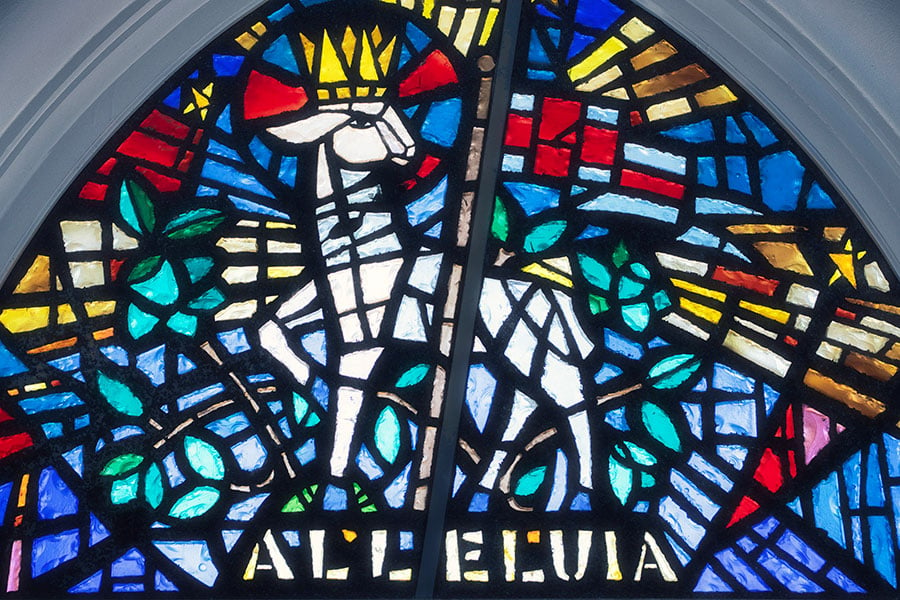
A stained glass window at St. Joseph Parish in Rhineland (NTC/Juan Guajardo)
What’s the first image that comes to mind when someone mentions Easter? For many, it’s the popular Easter bunny — especially ones molded in chocolate, wrapped in cellophane, and displayed on a store shelf.
Introduced to America by German immigrants who settled in Pennsylvania in the 1700s, the idea of an Easter Bunny leaving treats and colorful eggs for children started with Eostre, the Teutonic goddess of fertility often pictured cradling a rabbit or hare. It’s believed missionaries, evangelizing in Europe, used a rabbit’s easy ability to produce new life, along with its emergence from an underground burrow in the spring, to explain the Resurrection and make the transition to Christianity easier for new converts.
Easter is rich in traditions and symbols rooted in pagan, Jewish, and Christian history. Having evolved over the centuries, religious symbols celebrating Christ’s victory over death convey concepts concerning man’s relationship to the sacred and divine.
“They’re important to our faith because they connect us with something physical — something we’ve already experienced — to the transcendent,” said Chris Vaughan, diocesan director of marriage and family life.
Catholic symbols help deepen faith and shape prayer by bridging the material and spiritual worlds.
“When you look at a crucifix, it’s not really Jesus hanging on the cross, but it causes your mind to contemplate His suffering before the Resurrection,” he explained. “The Paschal candle reminds us that Christ is the light of the world.”
The Lamb of God
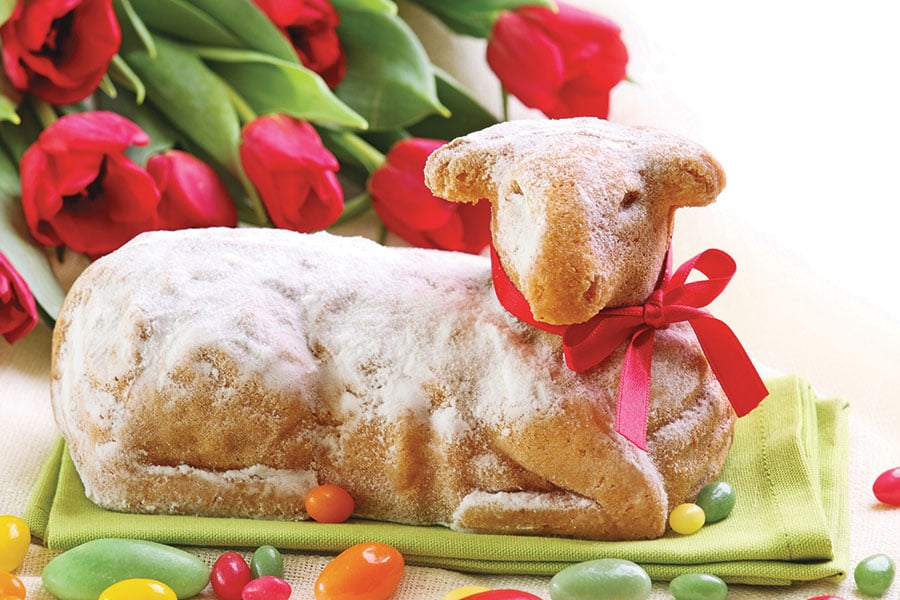
While the commercial celebration of Easter centers around chicks (especially the colorful, marshmallow Peeps), bunnies, and dyeing eggs, the most strongly Christian symbol of Easter is the lamb.
In the Old Testament account of the Exodus, the Israelites painted doorposts with the blood of an unblemished lamb so the Angel of Death would recognize the sacrifice and “pass over” the home, sparing their firstborn children.
Today, Jews commemorate their Exodus from slavery in Egypt during Passover — one of the most celebrated holidays in Judaism.
The Last Supper for Jesus and His disciples was a Passover Seder where He used elements of the meal — unleavened bread and wine — to foretell His impending suffering and death. For Christians, the Passover is symbolic of Jesus delivering those who trust in Him from the slavery of sin.
“In the Gospel, John the Baptist calls Jesus the Lamb of God (John 1:29). Why does he do that?” Vaughan asked rhetorically. “Jesus is unblemished, without sin, and He’s sacrificed. The lamb symbolizes Jesus’ death on Good Friday.”
Butter, cakes, and candy, fashioned from lamb molds, fill homes during the Easter season.
Another decor element is the fragrant potted lily, but the addition of the springtime flower is more than just aesthetic.
“Their blooms are shaped like a trumpet. In the Jewish faith, people are called to worship by blowing the Shofar — a ram’s horn,” Vaughan pointed out. “So the trumpet is a sign of worship and when Christ returns, which is what we anticipate with the Resurrection, the angels will blow trumpets.”
Lilies also represent purity, which is why saints who die as virgin martyrs are often pictured holding the flower.
When it comes to passing on the faith, what parents do is as important as what they say, the seasoned catechist urged.
Including symbols in liturgical celebrations and feast days, like arranging a vase of roses for Our Lady of Guadalupe or leaving out shoes on St. Nicholas Day, will instill memories in impressionable young minds.
“When children grow up, they remember those things,” Vaughan, a father of six, continued.
“If they stray from the faith, it’s those celebrations that will serve as an anchor to bring them back.”
Celebrating beyond Easter Sunday
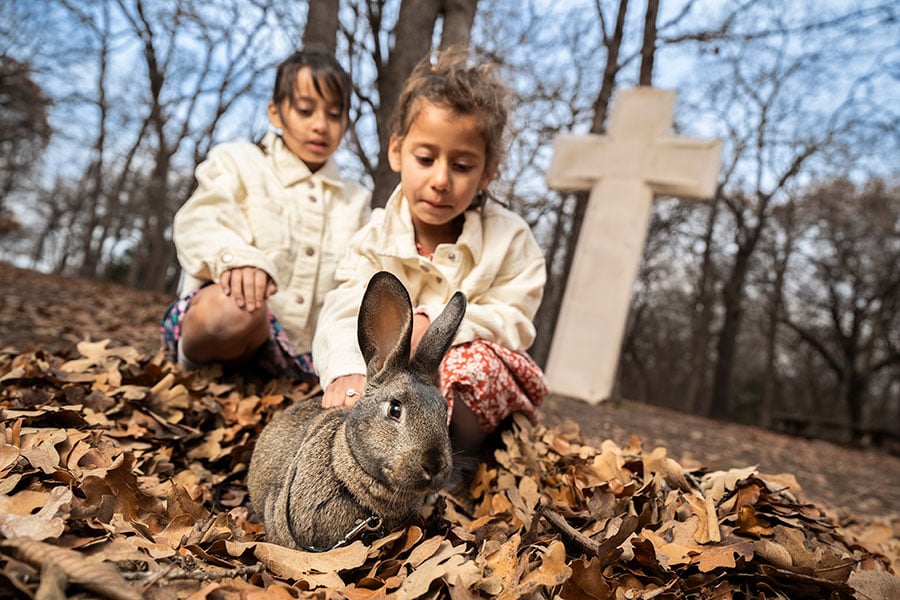
Maria Morrow uses a similar logic in raising her seven children.
The author of “A Busy Parent’s Guide to a Meaningful Lent” encourages a love of the Catholic faith by incorporating liturgical celebrations into family life.
“It will be difficult for them to leave the faith if they’ve had a lot of positive experiences,” reasoned the busy mom who embraces many traditional customs like Easter baskets, dyeing Easter eggs, and baking a lamb cake for the holiday.
But for the Morrow clan, the celebration extends beyond Easter Sunday. While the secular world quickly begins planning for the next holiday, the theologian makes a concerted effort to make all 50 days of Eastertide special for her brood. The decorations stay up, and Morrow indulges her youngsters with discounted Easter chocolate, family gatherings, and outdoor activities.
The University of Notre Dame graduate and her husband live simply but consider Easter a time for a little extravagance.
“It’s the one season of the year when I buy fresh flowers,” Morrow explained. “When one bouquet wilts, I buy another.”
In addition to the lily, other springtime blossoms are steeped in symbolism. Daffodils represent hope and resilience; purple tulips express faith; and the iris is a sign of Christ’s Passion and Resurrection.
“I feel flowers present the season of Easter in a very vivid way,” she emphasized. “The Easter season is a good time to get everyone out to see the cherry blossoms and local parks where flowers are coming out.”
Walks in nature can lead to discussions about the symbolism butterflies or the dogwood tree bring to Easter.
Just as butterflies emerge from a chrysalis, Jesus emerges from the tomb three days after the crucifixion.
According to legend, the dogwood tree provided the wood used to build the cross on which Jesus died. Cursed because of its role in the crucifixion, the tree would never grow large branches again, but its flowers were blessed with white petals that form the shape of a cross.
Morrow advises families to make the home brighter and more cheerful during the Easter season. Appreciating the increased sunlight that follows the spring equinox is another recommendation.
“Make sure you’re talking to your kids and reminding them it’s still Easter,” she suggested. “Even the smallest practices that focus on the Resurrection, and the idea we’ve been saved, can bring joy to the family and pay off for the future of our children.”
Beautiful eggs and new life
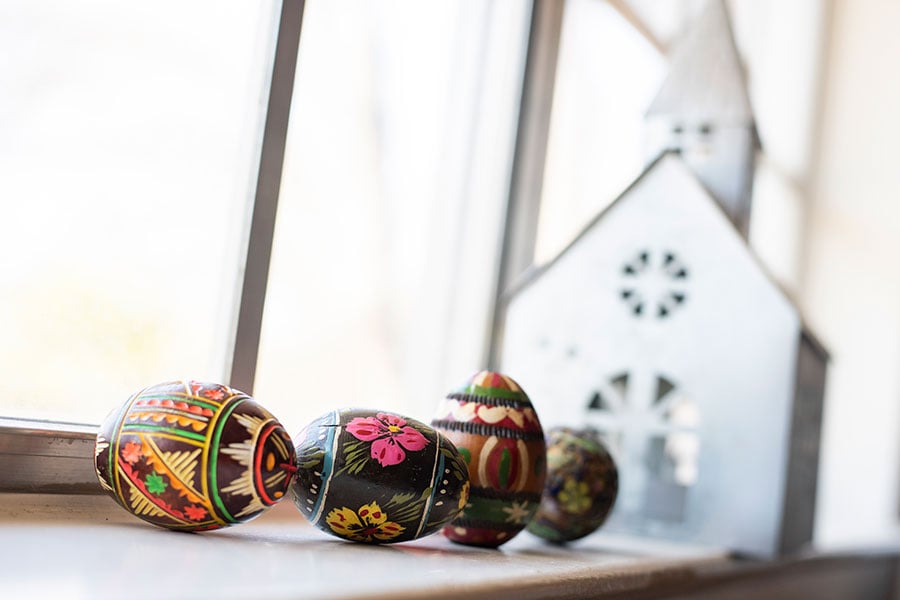
As Easter approaches, Sharon Kapavik Perkins keeps a bowl of beautifully embellished eggs in the foyer of her Aubrey, Texas, home.
Designed using wax and dyes to create intricate folk patterns, the collection of Czech Easter eggs, known as kraslice, are a nod to both her faith and heritage.
Rich in meaning and symbolism, the elaborate eggs are an art form found in many Eastern European countries. In Ukraine, the eggs are called pysanky and in Poland, pisanki. Techniques and styles differ from region to region.
“The egg symbolizes new life, and I became so intrigued by the beauty and design of these eggs, they became standard Easter decor for me,” explained the former diocesan employee who was introduced to kraslice during a vacation to Czechoslovakia in 1986.
Her first acquisition was a goose egg, featuring the images of Saints Cyril and Methodius, given to her by a Czech relative during the trip.
“They are considered the fathers of Catholicism in Czechoslovakia, and their feast day is a national holiday,” she explained.
For Perkins, handcrafted eggs, wreaths made with palms, and signs declaring “He is Risen” allow her to emphasize the Christian significance of the Easter season. You won’t find pastel bunnies on her fireplace mantle.
“It’s another way to resist the commercialization and secularization of Easter that I see all around me,” she observed. “For me, using religious symbols is a form of evangelization — a public witness.”
Coloring Easter eggs with her young grandson last year provided an opportunity to impart the family’s faith heritage and explain the true meaning behind the custom.
In Christianity, the hard-boiled Easter egg represents the Resurrection of Christ. Breaking the eggshell is the opening of the tomb, the egg white is Jesus’ burial shroud, and the yolk symbolizes Jesus — the source of life.
“Symbols are the best teaching tools, especially for young children,” Perkins asserted, remembering how her mother would light a blessed candle and burn a sacramental palm as a storm approached. “Those are the things that stick in your imagination as a young child, and you never forget them.”
The symbolism of Easter food
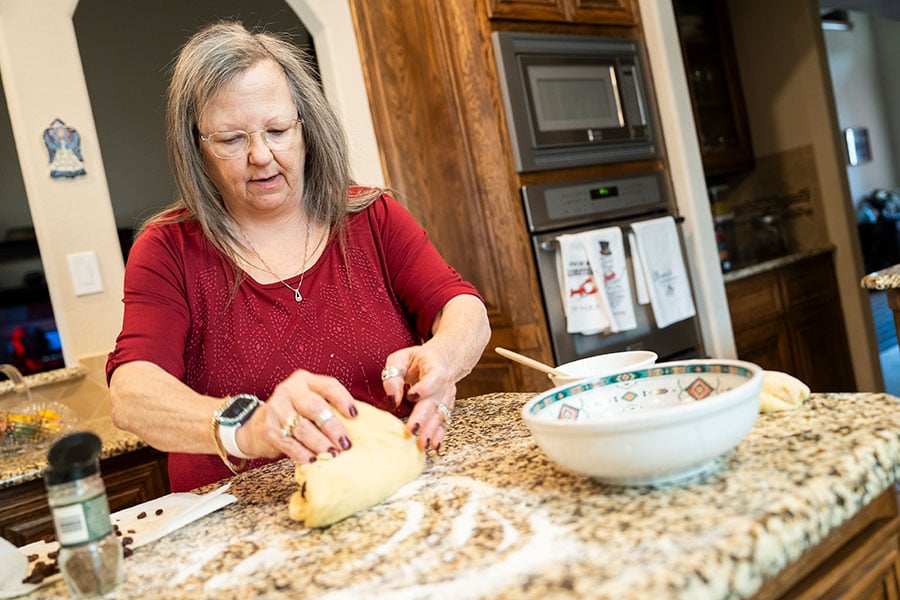
The aroma of paska dough, wafting from the oven on Holy Saturday, stirs memories of childhood Easters for Annette Baker.
Enriched with egg yolks, butter, and raisins, the sweet bread is a recipe passed down through generations of Eastern European families who came to America from Poland, Ukraine, Hungary, and the Czech Republic. Traditionally made to celebrate Easter, the soft, round loaves represent Jesus Christ — the Bread of Life — and are often embellished with crosses or other religious symbols.
“Every Holy Saturday, my mother would bake and cook, and she always made paska,” said the cradle Catholic of Czech and Hungarian heritage. “She would decorate the top with a braid of dough to represent the Crown of Thorns and sometimes put three crosses in the center.”
The delicately flavored bread was one of the most important foods prepared for the “Blessing of the Easter Basket” — a centuries-old Catholic ritual for families of Eastern European origin.
Along with ham, pickled eggs, butter, salt, and sausage, the paska was placed in a basket, covered with the family’s best linen (symbolizing Christ’s burial cloth) then carried to the church for a blessing on Holy Saturday.
Other items placed in the basket for the first Easter meal might include a special Easter cheese called cirak or hrudka (signifying the moderation Christians should have at all times); horseradish, pepper, oil, and vinegar (a reminder of the Passion of Christ and the bitter herbs of the Passover); and wine (representing the Blood of the Lord).
Salt symbolizes a Christian’s commitment to follow Christ’s words, “You are the salt of the earth” (Matthew 5:13).
“We always kept the blessed salt in a special shaker and used it for Sunday meals and other occasions,” Baker remembered. “It wouldn’t be Easter without my mother’s paska recipe. It’s a reminder of the importance of family.”
Another bread strongly linked to Easter is the hot cross bun. Traditionally eaten every Good Friday in Ireland, England, Canada, New Zealand, Australia, and the United States, the dough is prepared with spices some believe were used to embalm Jesus before He was buried.
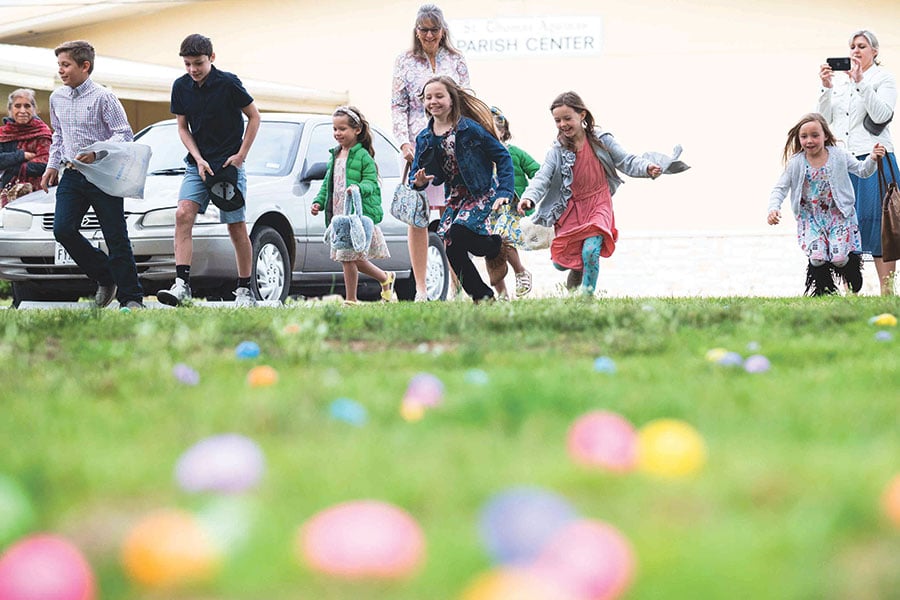
In the 12th century, an English monk began decorating his freshly baked buns with a cross on Good Friday to signify the crucifixion. The custom gained traction, and over the years, fruits were included in the batter to represent health and prosperity. In some recipes, orange peel is added to reflect the bitterness of Jesus’ time on the cross.
Be intentional
Whether it’s cooking special foods, decorating eggs, or buying Easter lilies, Chris Vaughan suggests celebrating the Resurrection in a studied, purposeful way. Using religious symbols in the home can focus prayer and help children understand difficult theological concepts.
“If we’re going to hand down our faith, we have to do things with intention. Kids see intention,” said the experienced catechist. “They can see where our priorities are.”
Americans go all out inviting guests to a big party and barbecue for the Fourth of July because it’s important.
“We should show that same enthusiasm for religious feasts,” Vaughan opined. “What we do is as important as what we say.”
